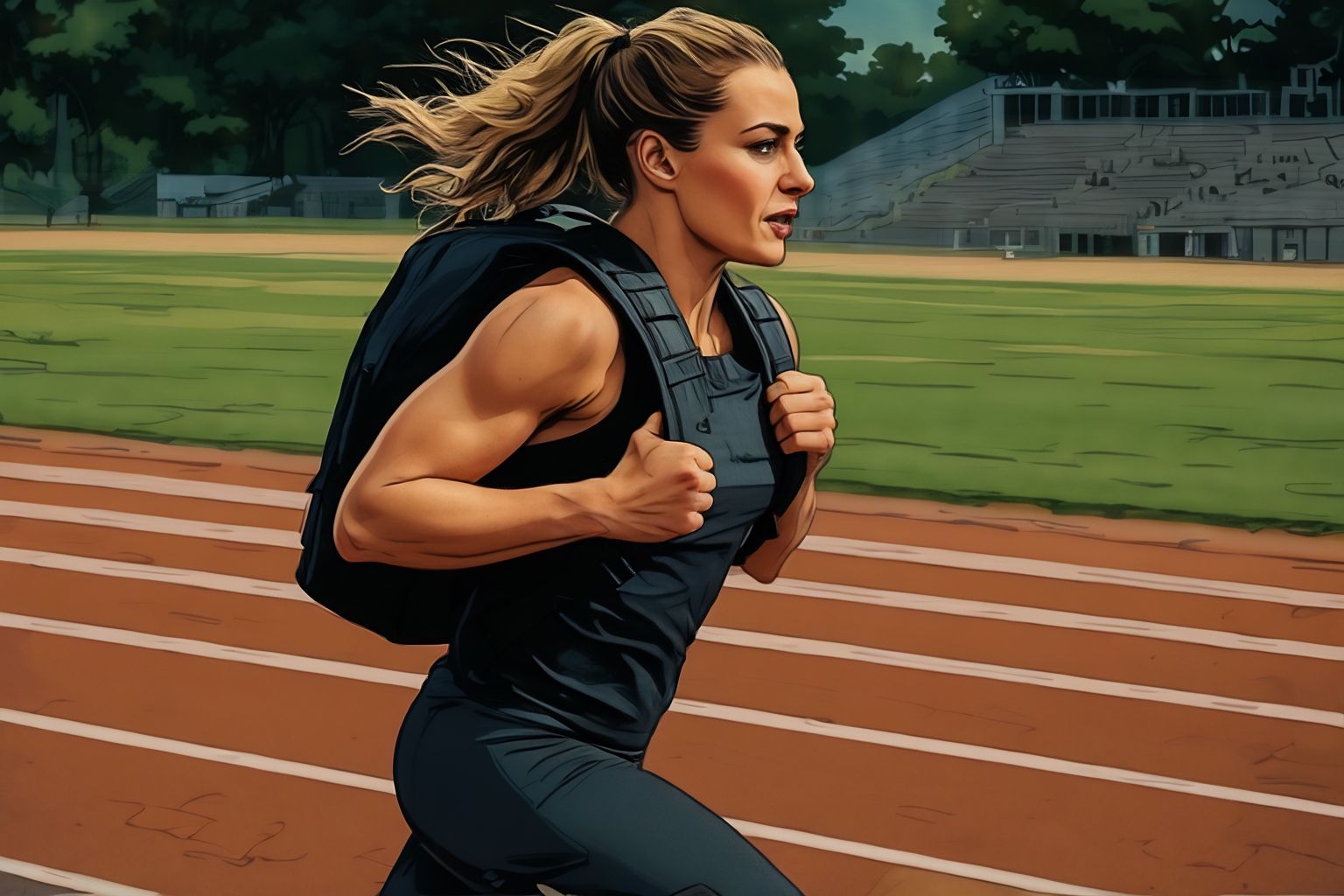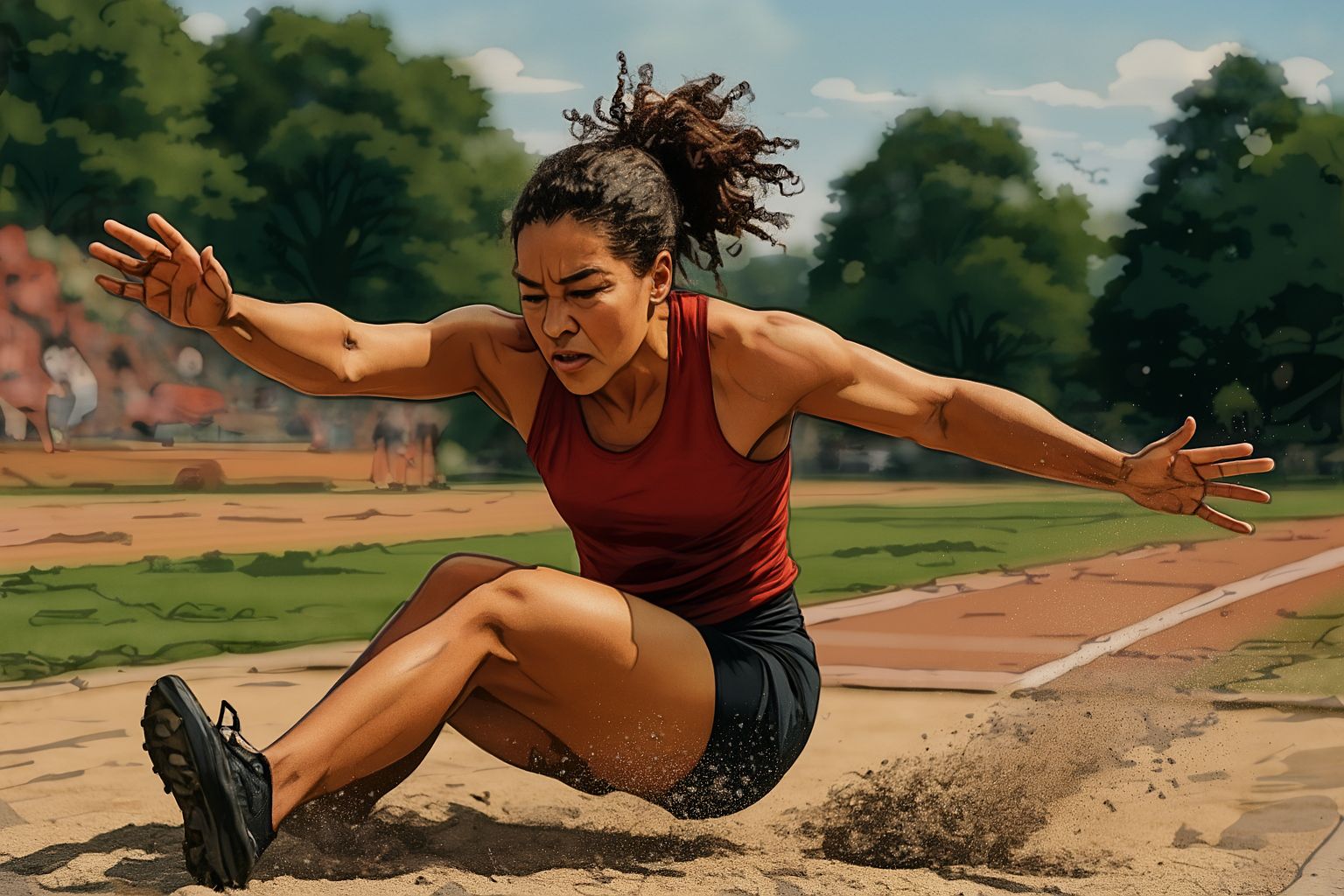Conquering the Decathlon: Looking At Each Event
The decathlon is often regarded as the ultimate test of an athlete’s versatility. A true decathlete is someone who can sprint, jump, throw, hurdle, vault, and endure—sometimes all in one competition. Competing in ten different events over two grueling days, a decathlete must be physically and mentally prepared for a wide range of challenges. Each of the ten events has its own intricacies and demands, and mastering each one is no small feat.
In this article, we’ll dive into each of the ten decathlon events, offering tips and insights on how to excel in every one of them. Whether you’re just starting your decathlon journey or looking to fine-tune your skills, understanding the specific challenges and techniques required for each event is essential. Let’s break down the decathlon events and explore how to approach them with confidence and precision.
Event 1: 100 Meters – Speed and Explosion
The 100 meters is the first event of the decathlon and serves as an immediate test of explosive speed. It’s over in a matter of seconds, but how you approach this event can set the tone for the rest of the competition. The key to excelling in the 100 meters lies in maximizing your acceleration and maintaining top speed through proper technique.
Focus on perfecting your start, which is essential in a sprint. A great start can help you build momentum and gain a lead early in the race. To achieve this, work on explosive power through sprint drills, plyometrics, and weight training for the legs. Speed work should focus on improving your top-end speed and maintaining it over the duration of the race. Ensure you’re focusing on form throughout the sprint—keeping your body aligned and your strides powerful.
Breathing is crucial in sprinting. Many athletes forget to breathe properly during the 100 meters, but taking controlled breaths can help maintain your energy levels and improve your overall performance.
Event 2: Long Jump – Technique and Power
The long jump is one of the most technical events in the decathlon. To achieve maximum distance, you need a combination of speed, strength, and precise jumping technique. A good jump involves a powerful takeoff, efficient flight, and a controlled landing.
Start by developing the strength in your legs through squats, lunges, and plyometric exercises like box jumps. Speed and explosiveness are equally important, so include sprints and short bursts of acceleration in your training. Work on your running technique to ensure that you’re maximizing your approach. Focus on your speed and approach angle as you approach the takeoff board—having a controlled, consistent approach is key to achieving a longer jump.
Once you’re in the air, make sure to drive your knees forward to create more distance. As for landing, try to extend your legs forward as much as possible to maximize the distance, and land with your feet, not your backside. Perfecting these movements requires practice, consistency, and confidence.
Event 3: Shot Put – Strength, Technique, and Timing
The shot put is all about power and technique. It’s not just about pushing the shot put as hard as possible; it’s about using your body efficiently to create maximum force in a single movement. The shot put is an event that requires coordination between the legs, hips, and arms, as well as a precise timing of your body movements.
Focus on building upper body strength, particularly in the shoulders, arms, and chest. Compound exercises like bench presses, overhead presses, and push-ups are important to strengthen these muscles. Additionally, work on your core and lower body strength through squats and deadlifts, as they help stabilize your body during the throw.
Your technique in the shot put should be focused on the glide or rotational style of throwing, depending on what you prefer. Both techniques require a precise movement of your hips and torso to generate power. The glide involves stepping back with one leg and propelling the shot forward using your body’s momentum, while the rotational style uses a spinning motion to increase distance. Practice with light shot puts first to perfect your form before working with heavier weights.
Event 4: High Jump – Elevate Your Technique
The high jump is another event that requires a unique combination of speed, strength, and technique. In the high jump, the goal is to clear the bar without knocking it down, which requires a refined technique for both takeoff and clearance.
The key to the high jump is the approach. Make sure to approach the bar at a slight angle, which will allow you to better generate upward momentum. The takeoff is essential; push through your takeoff leg and rotate your body as you jump. Focus on using your arms to propel yourself upward, while your legs should tuck in to clear the bar efficiently.
Flexibility in your hips and legs is essential for a successful jump, so incorporate regular stretching routines into your training. Flexibility will help you better clear the bar and improve your overall jump height.
Event 5: 400 Meters – Speed Endurance
The 400 meters is an event that requires both speed and endurance. It’s a one-lap sprint around the track, and it’s often referred to as one of the most demanding events in track and field. To excel in the 400 meters, you need to develop both your sprinting speed and your ability to sustain that speed over an entire lap.
Interval training is key to improving your performance in the 400 meters. Focus on short, intense sprints followed by brief recovery periods to help build the endurance needed for this event. Tempo runs, where you maintain a steady but fast pace over longer distances, will help you learn how to pace yourself through the 400-meter race.
Proper pacing and energy management are critical to this event. Start strong but don’t burn out in the first 200 meters. Focus on maintaining your speed through the backstretch and reserve enough energy for the final 100 meters to finish strong.
Event 6: 110 Meters Hurdles – Agility and Speed
The 110 meters hurdles is a true test of agility and speed. In this event, athletes must sprint at full speed while navigating over hurdles in their path. Precision, timing, and technique are key to navigating the hurdles without losing momentum.
Focus on developing your sprinting technique, as you need to maintain your top speed while clearing the hurdles. Incorporate hurdle drills into your training to improve your technique, including lead leg and trail leg mechanics. Work on your rhythm, as your strides between hurdles are just as important as the hurdles themselves. Learning to control your strides and maintain your speed while hurdling is crucial to finishing the race with a strong time.
Strengthen your core and upper body as well, since they help stabilize your body while hurdling. Explosive exercises like box jumps and resistance band sprints can help increase your power and agility.
Event 7: Discus Throw – Power, Precision, and Technique
The discus throw requires strength, precision, and impeccable technique. Like the shot put, the discus involves a rotational movement, but the angle and mechanics are different. The key to mastering the discus throw is generating speed and force through a well-timed spin, as well as releasing the discus at the optimal angle for maximum distance.
Incorporate exercises like squats and deadlifts to build strength in your legs and core. Work on rotational movements through medicine ball throws, cable rotations, and kettlebell swings to simulate the motion used in the discus throw. Developing flexibility in your shoulder and wrists will also help you release the discus at the optimal angle.
Mastering the timing of the spin is essential for a successful throw. You need to generate power as you spin, maintaining control of the discus until the last moment before release.
Event 8: Pole Vault – Technique and Mental Strength
The pole vault is one of the most challenging and exciting events in the decathlon. It requires a combination of technique, strength, and mental fortitude. Vaulting over a high bar with only a pole for support demands both power and precision.
The key to the pole vault is mastering the plant, takeoff, and clearance. Proper timing and technique are critical to successfully vaulting over the bar. Training should include exercises that focus on explosive power in the legs and core, as well as improving your overall grip and arm strength.
The pole vault also demands mental toughness. It can be intimidating to fly through the air, and overcoming that fear is crucial. Confidence, along with repeated practice, is the key to success in this event.
Event 9: Javelin Throw – Technique and Control
Like the shot put and discus, the javelin throw is a technical event that combines strength, power, and coordination. Proper technique is vital in this event, as the angle, speed, and release of the javelin all play a role in achieving distance.
Work on building upper body strength, particularly in the shoulders and arms, through exercises like overhead presses and cable rows. Strengthen your legs and core through squats, lunges, and medicine ball throws, as they contribute to the explosive power needed to propel the javelin.
Proper technique involves ensuring the javelin is held at the correct angle and released with optimal speed and control. Focus on your grip, arm motion, and follow-through, all of which contribute to a successful throw.
Event 10: 1500 Meters – Endurance and Mental Toughness
The 1500 meters is the final event of the decathlon and serves as a true test of endurance. After two days of intense competition, decathletes must summon every ounce of energy to finish strong. Mental toughness is critical in this event, as it requires you to maintain your pace even as fatigue sets in.
Endurance training, including long runs and interval workouts, should be part of your preparation for the 1500 meters. Focus on pacing yourself through the race, conserving enough energy for a strong finish. Break the race down into segments, focusing on maintaining a steady pace throughout each lap, and use the final 400 meters to push yourself toward the finish line.
Conquering the Decathlon: The Ultimate Test of Athleticism
The decathlon is undoubtedly one of the most demanding athletic competitions, but with the right preparation, training, and mindset, excelling in each of the ten events is within reach. The key to success in the decathlon is versatility—being able to adapt and perform at a high level across all ten events. Through dedicated training, technical refinement, and mental strength, you can conquer the decathlon and emerge as a well-rounded, all-around athlete.
Conquering the Decathlon: Looking At Each Event
The decathlon is often regarded as the ultimate test of an athlete’s versatility. A true decathlete is someone who can sprint, jump, throw, hurdle, vault, and endure—sometimes all in one competition. Competing in ten different events over two grueling days, a decathlete must be physically and mentally prepared for a wide range of challenges. Each of the ten events has its own intricacies and demands, and mastering each one is no small feat.
In this article, we’ll dive into each of the ten decathlon events, offering tips and insights on how to excel in every one of them. Whether you’re just starting your decathlon journey or looking to fine-tune your skills, understanding the specific challenges and techniques required for each event is essential. Let’s break down the decathlon events and explore how to approach them with confidence and precision.
Event 1: 100 Meters – Speed and Explosion
The 100 meters is the first event of the decathlon and serves as an immediate test of explosive speed. It’s over in a matter of seconds, but how you approach this event can set the tone for the rest of the competition. The key to excelling in the 100 meters lies in maximizing your acceleration and maintaining top speed through proper technique.
Focus on perfecting your start, which is essential in a sprint. A great start can help you build momentum and gain a lead early in the race. To achieve this, work on explosive power through sprint drills, plyometrics, and weight training for the legs. Speed work should focus on improving your top-end speed and maintaining it over the duration of the race. Ensure you’re focusing on form throughout the sprint—keeping your body aligned and your strides powerful.
Breathing is crucial in sprinting. Many athletes forget to breathe properly during the 100 meters, but taking controlled breaths can help maintain your energy levels and improve your overall performance.
Event 2: Long Jump – Technique and Power
The long jump is one of the most technical events in the decathlon. To achieve maximum distance, you need a combination of speed, strength, and precise jumping technique. A good jump involves a powerful takeoff, efficient flight, and a controlled landing.
Start by developing the strength in your legs through squats, lunges, and plyometric exercises like box jumps. Speed and explosiveness are equally important, so include sprints and short bursts of acceleration in your training. Work on your running technique to ensure that you’re maximizing your approach. Focus on your speed and approach angle as you approach the takeoff board—having a controlled, consistent approach is key to achieving a longer jump.
Once you’re in the air, make sure to drive your knees forward to create more distance. As for landing, try to extend your legs forward as much as possible to maximize the distance, and land with your feet, not your backside. Perfecting these movements requires practice, consistency, and confidence.
Event 3: Shot Put – Strength, Technique, and Timing
The shot put is all about power and technique. It’s not just about pushing the shot put as hard as possible; it’s about using your body efficiently to create maximum force in a single movement. The shot put is an event that requires coordination between the legs, hips, and arms, as well as a precise timing of your body movements.
Focus on building upper body strength, particularly in the shoulders, arms, and chest. Compound exercises like bench presses, overhead presses, and push-ups are important to strengthen these muscles. Additionally, work on your core and lower body strength through squats and deadlifts, as they help stabilize your body during the throw.
Your technique in the shot put should be focused on the glide or rotational style of throwing, depending on what you prefer. Both techniques require a precise movement of your hips and torso to generate power. The glide involves stepping back with one leg and propelling the shot forward using your body’s momentum, while the rotational style uses a spinning motion to increase distance. Practice with light shot puts first to perfect your form before working with heavier weights.
Event 4: High Jump – Elevate Your Technique
The high jump is another event that requires a unique combination of speed, strength, and technique. In the high jump, the goal is to clear the bar without knocking it down, which requires a refined technique for both takeoff and clearance.
The key to the high jump is the approach. Make sure to approach the bar at a slight angle, which will allow you to better generate upward momentum. The takeoff is essential; push through your takeoff leg and rotate your body as you jump. Focus on using your arms to propel yourself upward, while your legs should tuck in to clear the bar efficiently.
Flexibility in your hips and legs is essential for a successful jump, so incorporate regular stretching routines into your training. Flexibility will help you better clear the bar and improve your overall jump height.
Event 5: 400 Meters – Speed Endurance
The 400 meters is an event that requires both speed and endurance. It’s a one-lap sprint around the track, and it’s often referred to as one of the most demanding events in track and field. To excel in the 400 meters, you need to develop both your sprinting speed and your ability to sustain that speed over an entire lap.
Interval training is key to improving your performance in the 400 meters. Focus on short, intense sprints followed by brief recovery periods to help build the endurance needed for this event. Tempo runs, where you maintain a steady but fast pace over longer distances, will help you learn how to pace yourself through the 400-meter race.
Proper pacing and energy management are critical to this event. Start strong but don’t burn out in the first 200 meters. Focus on maintaining your speed through the backstretch and reserve enough energy for the final 100 meters to finish strong.
Event 6: 110 Meters Hurdles – Agility and Speed
The 110 meters hurdles is a true test of agility and speed. In this event, athletes must sprint at full speed while navigating over hurdles in their path. Precision, timing, and technique are key to navigating the hurdles without losing momentum.
Focus on developing your sprinting technique, as you need to maintain your top speed while clearing the hurdles. Incorporate hurdle drills into your training to improve your technique, including lead leg and trail leg mechanics. Work on your rhythm, as your strides between hurdles are just as important as the hurdles themselves. Learning to control your strides and maintain your speed while hurdling is crucial to finishing the race with a strong time.
Strengthen your core and upper body as well, since they help stabilize your body while hurdling. Explosive exercises like box jumps and resistance band sprints can help increase your power and agility.
Event 7: Discus Throw – Power, Precision, and Technique
The discus throw requires strength, precision, and impeccable technique. Like the shot put, the discus involves a rotational movement, but the angle and mechanics are different. The key to mastering the discus throw is generating speed and force through a well-timed spin, as well as releasing the discus at the optimal angle for maximum distance.
Incorporate exercises like squats and deadlifts to build strength in your legs and core. Work on rotational movements through medicine ball throws, cable rotations, and kettlebell swings to simulate the motion used in the discus throw. Developing flexibility in your shoulder and wrists will also help you release the discus at the optimal angle.
Mastering the timing of the spin is essential for a successful throw. You need to generate power as you spin, maintaining control of the discus until the last moment before release.
Event 8: Pole Vault – Technique and Mental Strength
The pole vault is one of the most challenging and exciting events in the decathlon. It requires a combination of technique, strength, and mental fortitude. Vaulting over a high bar with only a pole for support demands both power and precision.
The key to the pole vault is mastering the plant, takeoff, and clearance. Proper timing and technique are critical to successfully vaulting over the bar. Training should include exercises that focus on explosive power in the legs and core, as well as improving your overall grip and arm strength.
The pole vault also demands mental toughness. It can be intimidating to fly through the air, and overcoming that fear is crucial. Confidence, along with repeated practice, is the key to success in this event.
Event 9: Javelin Throw – Technique and Control
Like the shot put and discus, the javelin throw is a technical event that combines strength, power, and coordination. Proper technique is vital in this event, as the angle, speed, and release of the javelin all play a role in achieving distance.
Work on building upper body strength, particularly in the shoulders and arms, through exercises like overhead presses and cable rows. Strengthen your legs and core through squats, lunges, and medicine ball throws, as they contribute to the explosive power needed to propel the javelin.
Proper technique involves ensuring the javelin is held at the correct angle and released with optimal speed and control. Focus on your grip, arm motion, and follow-through, all of which contribute to a successful throw.
Event 10: 1500 Meters – Endurance and Mental Toughness
The 1500 meters is the final event of the decathlon and serves as a true test of endurance. After two days of intense competition, decathletes must summon every ounce of energy to finish strong. Mental toughness is critical in this event, as it requires you to maintain your pace even as fatigue sets in.
Endurance training, including long runs and interval workouts, should be part of your preparation for the 1500 meters. Focus on pacing yourself through the race, conserving enough energy for a strong finish. Break the race down into segments, focusing on maintaining a steady pace throughout each lap, and use the final 400 meters to push yourself toward the finish line.
Conquering the Decathlon: The Ultimate Test of Athleticism
The decathlon is undoubtedly one of the most demanding athletic competitions, but with the right preparation, training, and mindset, excelling in each of the ten events is within reach. The key to success in the decathlon is versatility—being able to adapt and perform at a high level across all ten events. Through dedicated training, technical refinement, and mental strength, you can conquer the decathlon and emerge as a well-rounded, all-around athlete.




